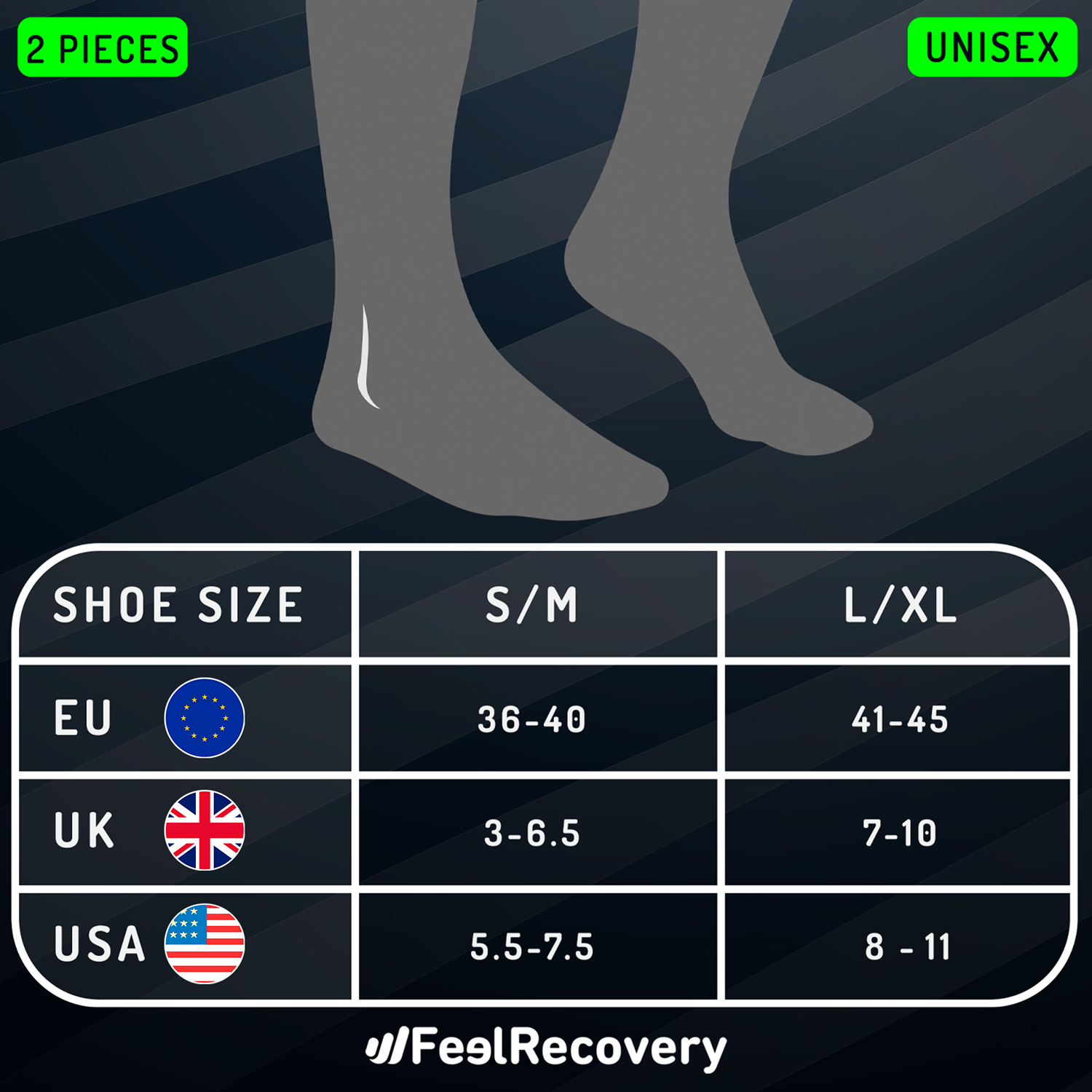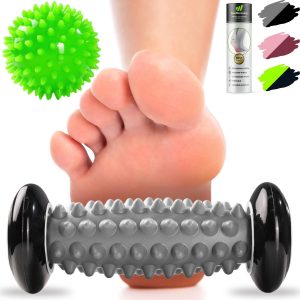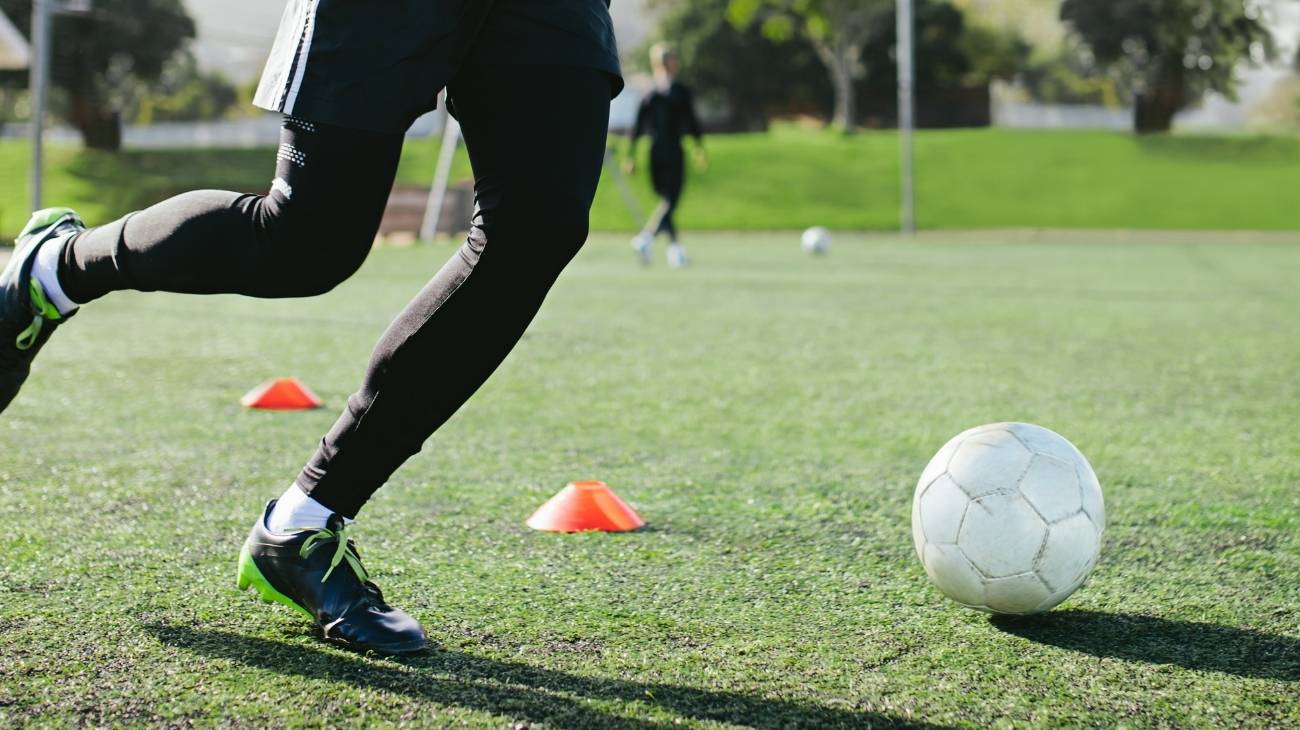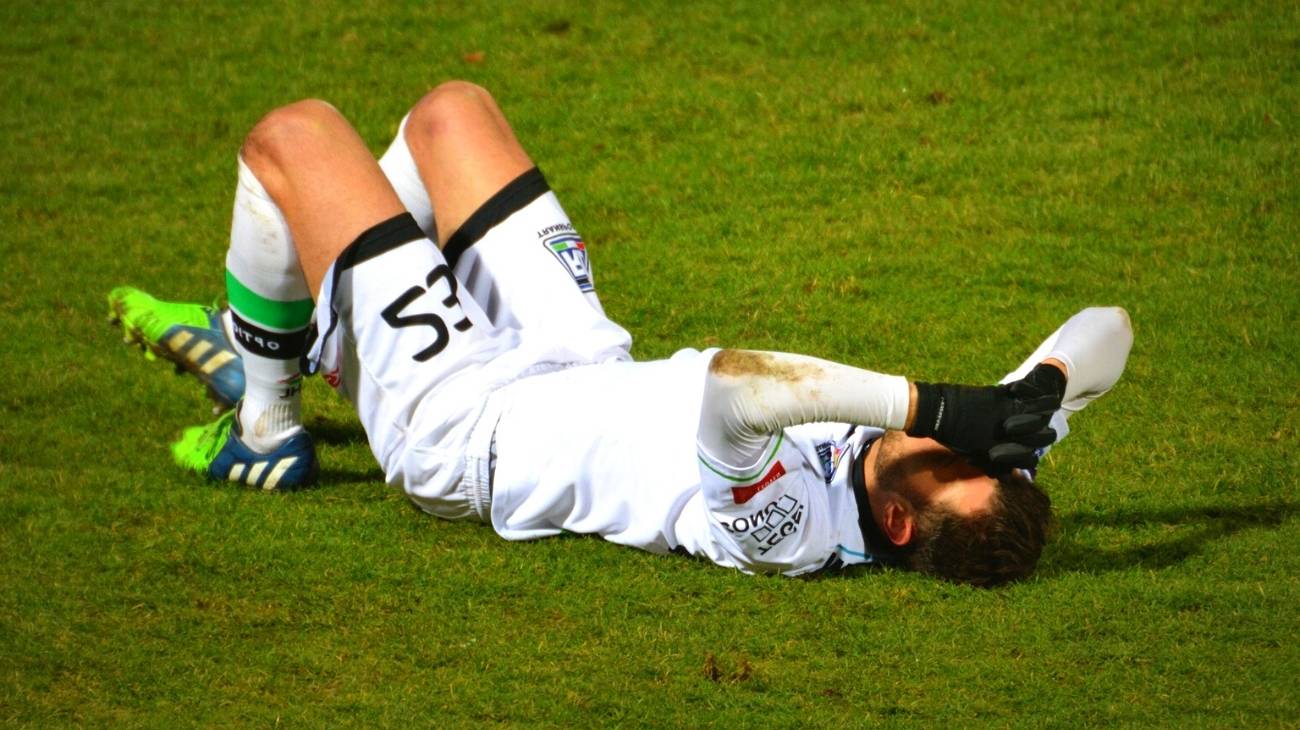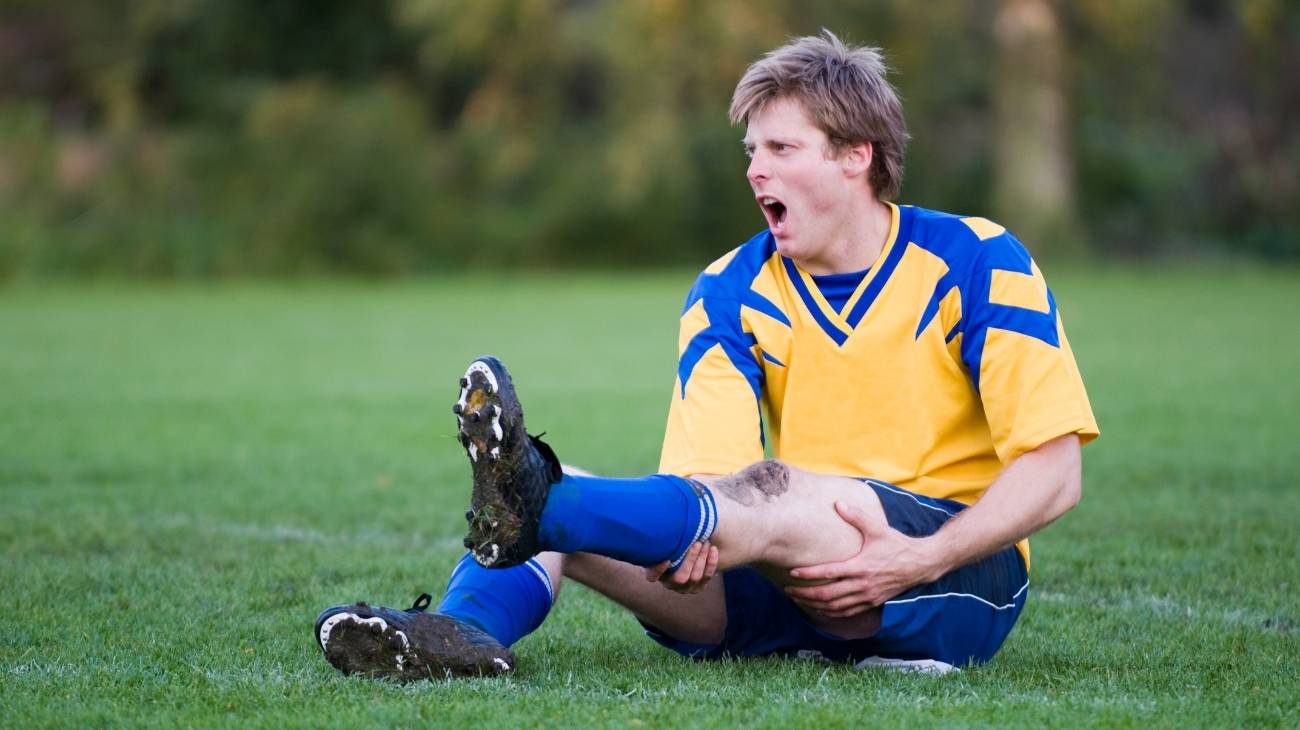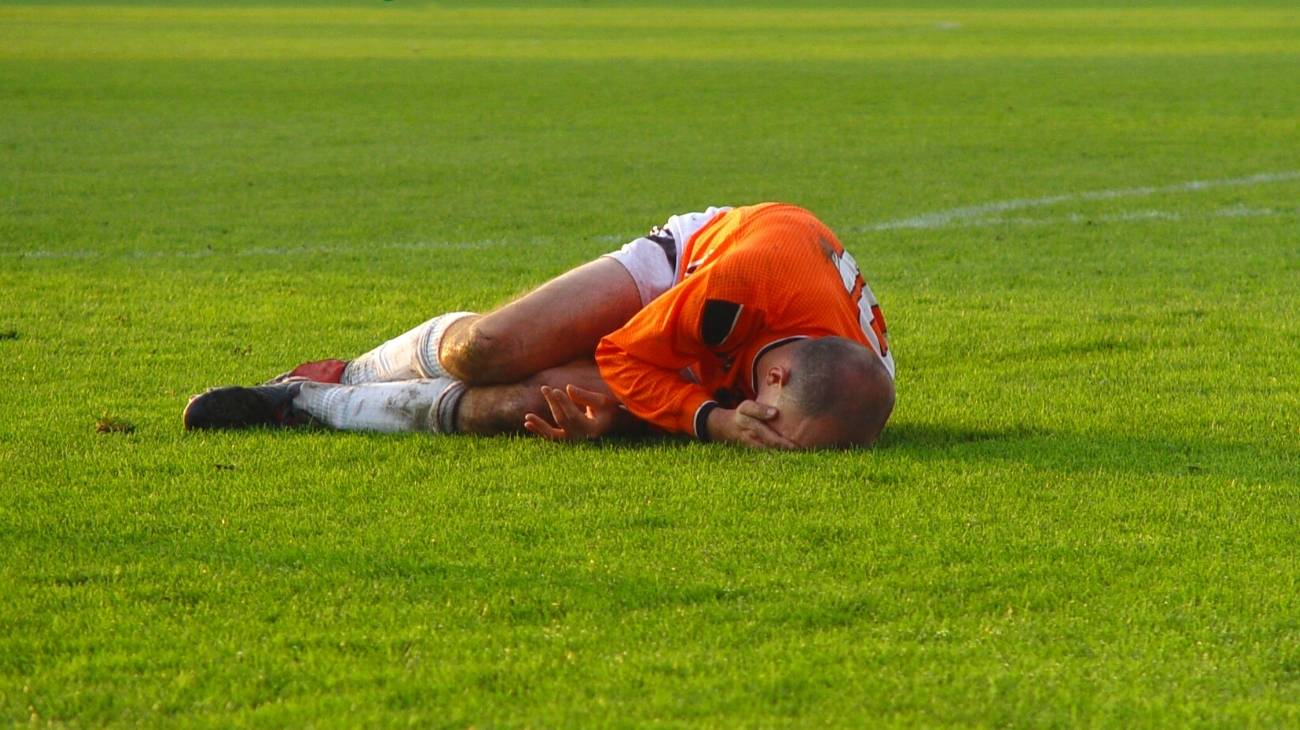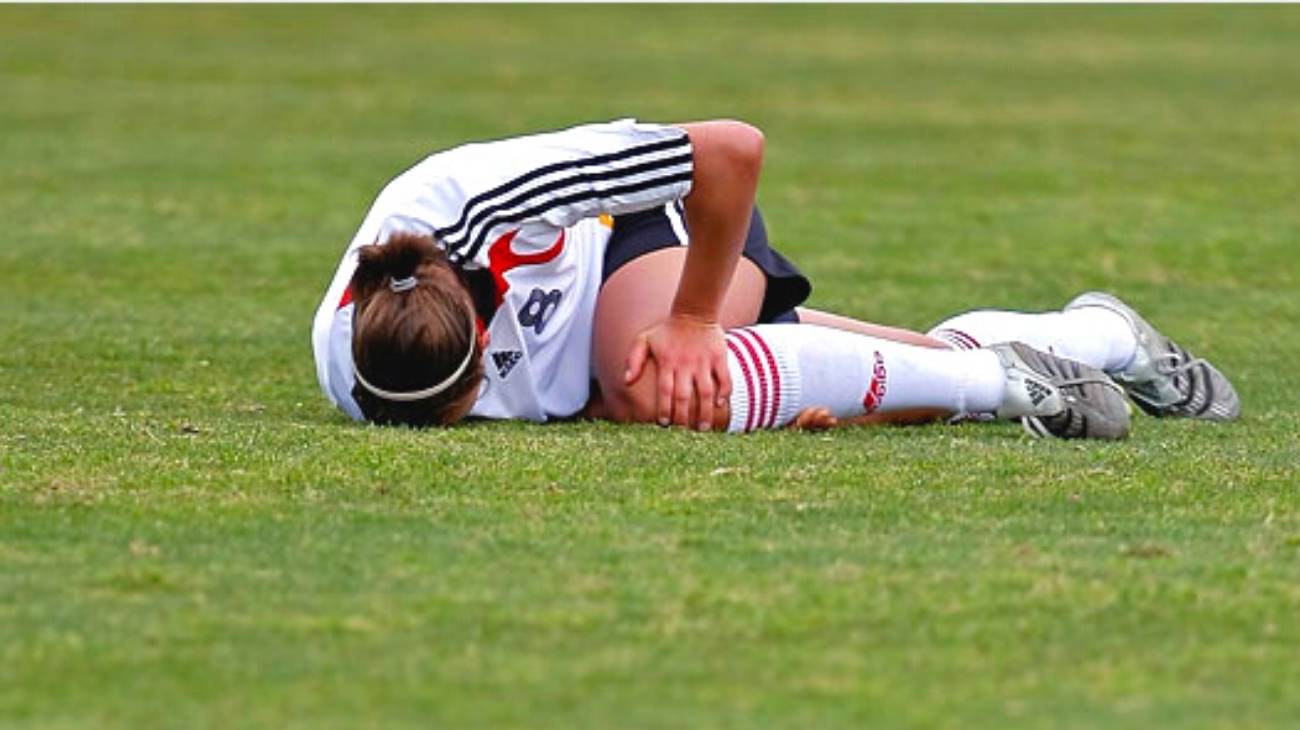Soccer is the most passionate sport on the planet. And while fans know about history and statistics, little do they know about the efforts of soccer players to do their best without getting injured.
We show you the most common types of soccer injuries and what steps to take to avoid them. You will also learn how to apply the PRICE therapy, which consists of first aid techniques. Finally, we will tell you when to see a specialist depending on the type of injury you have.
What are the most common types of injuries when playing soccer?
On average, in a European season there can be more than 2,200 injuries in more than 250,000 hours of training and competition. That's an average of 8 injuries per 1,000 hours of training. As you can see, the incidence of injuries in soccer is higher than in other sports such as baseball, so you should know the most common types of injuries in this team sport.
Muscle strain
It is not valid to talk about a single muscle because there are at least 15 muscles in the legs, separated into three major muscle groups. What happens in a muscle fibre rupture? The muscle fibres are actually torn and this causes sudden and intense pain, so there is no way to hide such an injury in a match.
The calf and back of the thigh muscles (hamstrings) are the most commonly injured, although it need not be due to a bad warm-up, because in 90 minutes of play, the body is exposed to a lot of stress and the muscles are likely to be strained in a sprint or a fall.
Sprained ankle
It may be due to an accidental action during play, but when it occurs, the player will almost certainly have to leave the field of play as the pain and risk of aggravating the injury is high. A sprain occurs when a joint performs an unnatural movement, which stretches and damages the ligaments that make up the joint.
In soccer it can happen in both the ankle and the knee and can be of 3 levels or degrees. In the first two degrees, the ligament receives partial damage, while in the last degree, this tissue is completely ruptured, which will almost certainly require surgical intervention.
Cruciate ligament injury
In sports such as soccer, where violent starts, changes of direction and stops are involved, this injury is typical. The cruciate ligament is injured when it is torn by overstretching or a strong, direct blow to the knee.
In this case the player will feel a loud pop in the knee followed by a very sharp pain that will put him out of action and possibly out with support or even on a stretcher. This injury is by far one of the worst injuries a soccer player can suffer as it requires surgery and a recovery of 3 to 6 months before he can play again.
Tendinopathies
By not treating tendinopathy properly, the tissue can rupture and require surgery. The tendons in the legs support up to 12 times the weight of the human body, however there are strains that exceed this limit. The Achilles tendon suffers the most. It is located behind the calf and connects to the heel.
Athletes often miss the signs of this injury and go to the sports doctor late, for fear of not being on sick leave. If treated and detected early, it may only lead to a few weeks of rest, but if the ligament ruptures, it will have to be surgically reconstructed and you will have to be off work for a long time.
Pubalgia
Pubalgia occurs when there are imbalances in the strength of the muscles related to the pubic area. The pain that occurs spreads to the adductors, abdominals and crural arches. With good training, the probability of suffering this injury decreases, although in soccer players, due to the amount of lateral displacements, it is very common to suffer from this ailment. Resting time may vary, although it does not exceed six months if there is a related hernia.
Muscle contractions
The high tension in the muscle fibres causes the tissues to contract and not relax again. It is dangerous if the soccer player performs a long distance run and this injury occurs. The consequence of the movements can make the injury aggravate and surgery may be required. The best thing to do is to rest for several minutes and start stretching and mobilising the affected area. If the pain continues, it is best to leave the field of play as this may be a warning sign of a more serious injury.
Concussion
Hard to imagine? It is quite possible for a header to end in a clash of heads between two players. Headaches are instantaneous in the event of a bad collision.
Keep in mind that the brain is soft and although it is protected by the skull, a strong blow can inflame it and create life-threatening haematomas. It is also possible that blood vessels may rupture and nerves may be affected, so it is best to stop playing immediately.
Meniscal tear
A meniscal tear is an injury caused by twisting of the knee while the foot is flat on the ground. The swelling of the knee may last for more than 24 hours and there is usually no bruising. However, only a sports doctor will tell you if it is a minor, temporary injury. When there is already a history of sprains, the knee is likely to be more sensitive to this specific injury.
It is common in soccer for a tackle by an opponent to cause a severe sprain that damages the meniscus and also the ligaments of the knee. It is a serious injury that can cause the athlete to be out for between 1 and 3 months.
Best products for soccer injury recovery
Bestseller
-
2 Ankle Compression Sleeve (Black/Gray)
$24.95 -
2 Ankle Compression Sleeve (Green/Navy)
$24.95 -
2 Ankle Compression Sleeve (Pink/Bordeaux)
$24.95 -
2 Calf Compression Sleeve (Black/Gray)
$24.95 -
2 Calf Compression Sleeve (Green/Navy)
$24.95 -
2 Calf Compression Sleeve (Pink/Bordeaux)
$24.95 -
2 Knee Compression Sleeve (Black/Gray)
$24.95 -
2 Knee Compression Sleeve (Green/Navy)
$24.95 -
2 Knee Compression Sleeve (Pink/Bordeaux)
$24.95 -
2 Thigh Compression Sleeve (Black/Gray)
$24.95 -
2 Thigh Compression Sleeve (Green/Navy)
$24.95 -
2 Thigh Compression Sleeve (Pink/Bordeaux)
$24.95 -
Ice Pack for Foot - Cold Therapy Socks (Black)
$24.95 -
Ice Pack for Foot - Cold Therapy Socks (Green)
$24.95 -
Ice Pack for Foot - Cold Therapy Socks (Pink)
$24.95 -
Microwavable Heated Slippers (Hearts)
$29.95 -
Microwavable Heated Slippers (Oxford)
$29.95 -
Microwavable Heated Slippers (Sport)
$29.95
-
2 Patella Knee Strap (Black/Gray)
$14.95 -
2 Patella Knee Strap (Green/Navy)
$14.95 -
2 Patella Knee Strap (Pink/Bordeaux)
$14.95 -
Foot Massage Roller for Plantar Fasciitis (Black)
$24.95 -
Foot Massage Roller for Plantar Fasciitis (Green)
$24.95 -
Foot Massage Roller for Plantar Fasciitis (Pink)
$24.95 -
Ice Massage Roller Ball (Black)
$39.95 -
Ice Massage Roller Ball (Green)
$39.95 -
Ice Massage Roller Ball (Pink)
$39.95 -
Sacroiliac Support Belt (Black)
$29.95 -
Sacroiliac Support Belt (Green)
$29.95 -
Sacroiliac Support Belt (Pink)
$29.95 -
Soft Density Foam Roller for Recovery (Black)
$39.95 -
Soft Density Foam Roller for Recovery (Green)
$39.95 -
Soft Density Foam Roller for Recovery (Pink)
$39.95 -
Sport Compression Socks (1 Pair) (Black/Gray)
$24.95 -
Sport Compression Socks (1 Pair) (Green/Navy)
$24.95 -
Sport Compression Socks (1 Pair) (Pink/Bordeaux)
$24.95
How to prevent injuries when playing soccer?
Only someone who has already experienced the physical stress of dozens of soccer matches will know what their weaknesses are and pay special attention to them. Check out this list of preventive measures you should take to avoid injuries in professional or amateur soccer.
Warm-up
The purpose of a good warm-up is to raise body temperature and prepare joints, tendons, ligaments and muscles for physical activity. There should be a general warm-up before a specific training session, as soccer is a sport in which the legs have to exert a lot of effort.
Walking, jogging and jogging are good ways to start a warm-up, especially in cold weather where the body has a slow biorhythm. You can then move on to stretching and mobility of the trunk and upper and lower limbs to adapt the joints to the intensity of soccer.
One of the most common causes of injuries in amateur athletes is the lack of warm-up, as due to lack of habit, forgetfulness or laziness, the training or match is started without a previous warm-up and this causes various problems when we want to perform a medium or high intensity effort.
Cooling down
Coaches and physical trainers opt for aerobic exercises and stretching exercises in order to give a successful end to the training they carry out each day. Treadmills, exercise bikes and elliptical trainers work perfectly to gradually bring the body back to its normal heart rate. It is not recommended that players suddenly stop training and then try to sit down or lie down.
What we want is for the muscles and other tissues to be ready (not sore or tight) for the next day's training or the weekend's match. When doing stretching exercises, the soccer player should stretch all parts of the body: neck, shoulders, biceps, triceps, chest, abdominals, back and legs. It only takes about 30 minutes and the body will return to its usual calm state.
Good equipment
Based on FIFA regulations, there are only five items of clothing allowed in a FIFA soccer match:
- T-shirts: They are made of polyester and as they are used in matches, it is recommended that the fabric is used in training clothes. It should be breathable and should not accumulate or obstruct the player's sweating process.
- Shorts: They should be made of synthetic material and their function is to repel sweat. They should not go above the knee so as not to hinder the mobility of the legs. At professional level, thermal shorts or protective tights are seen, accessories that are also validated by FIFA.
- Socks: Cotton socks are recommended for a better grip with the shoes. These have the function of supporting the shin guard and prevent scrapes in the event of a fall on the leg.
- Shin guard: The only hard object allowed in the kit, it is logical to think that the intensity of soccer should allow a minimum of protection for the legs. Playing and kicking actions easily lead to injuries and fractures.
- Shoes: There are different types of shoes for each type of surface or ground on which the game is played. FIFA sets minimum requirements and manufacturers must come up with new designs that are supportive rather than obstructive to the player's mobility.
Nutrition and hydration
Good nutrition is part of the secret for soccer players to have a long professional career or to play the sport as an amateur for many years. In 90 minutes of play, an athlete can burn around 2000 calories. A balanced diet of fats, proteins and carbohydrates should be on the menu for any athlete, especially in soccer where a person is required to remain athletic and maintain a balanced body weight.
In many cases, taking vitamins, minerals and fibre is best. They protect the soccer player from illness and help the body withstand the explosive movements of the sport. As soccer requires running for 90 minutes, interspersed with short and long runs, the energy demand is high. In this case foods such as potatoes, bread and rice help to provide sufficient energy.
Talking about hydration, water is as important as nutrition, while eating stores energy and gains strength, water transports all the nutrients required by the body. A good hydration plan should be personalised and adapted to the climatic conditions where the sport is practised.
Fitness level
Everyone is different, so there is no precise formula for how much a soccer player should weigh or how tall they should be. There are some general recommendations, such as for every 1.5 metres of height a player should weigh less than 50 kilos. What a good player should have are strong, sturdy and well-defined legs.
If you are underweight for your height, your performance is likely to be lower than expected. Cardiac and lung capacity should always be at 100%, otherwise when running with the ball, the player will not have a chance to defend against opponents for the full 90 minutes of a match.
Recovery therapies
There are multiple ways to achieve a better sports recovery, either through the use of cold, alternative and energetic options, or even massages that drain toxins.
Check out this short list of the options available:
- Sports massage: A good massage, whatever its purpose, should reactivate blood circulation, relieve pain, provide emotional and body balance and increase muscle temperature. In the event of a serious injury, it is not advisable to massage without a diagnosis from a specialist, as it is likely to be a fracture. Consult a good physiotherapist for the best technique according to the purpose you wish to achieve with massages.
- Use of hot and cold therapies: Cold increases the pain threshold, lowers the metabolism, acts as an analgesic and vasoconstrictor. By lowering the body temperature, it also decreases the release of vasodilators. In turn, the heat serves as a local vasodilator, bringing more blood to the injury and allowing for a different type of tissue recovery.
- Use of compression garments: In soccer, the use of compression garments can be summarised as compression socks, compression stockings and compression trousers. Technological and research advances in the field of soccer have been such that there are products dedicated to maintaining the body's energy, facilitating recovery from injury and relaxing tight muscles. These garments improve the distribution of blood flow and thus optimise oxygen consumption in the tissues. These benefits translate into improved performance for the soccer player.
- Use of acupressure therapies: This therapy is a modern modality based on acupuncture. It differs from acupuncture in that it does not use needles to be applied, but shares the same points and meridians that allow the free flow of energy. This energy is muscle tension that must be released for a better performance of the athlete. Using the fingers and palms of the hands, local points are activated where the discomfort is located. With acupressure it is possible to release the accumulated tension and allow a feeling of full relaxation.
- Use of thermotherapy and cryotherapy: Cryotherapy is the use of extreme cold for chronic injuries that require a slow but steady recovery. It is only possible to apply cold when sprains, muscle overloads, fibre ruptures, dislocations and tendonitis are diagnosed. In the case of thermotherapy, it can only be used once the inflammatory phase has passed, from 72 hours after the injury. Part of the therapy works to increase the temperature in the injured area so that the blood carries the nutrients that the tissues need to regenerate.
How to apply the RICE therapy to treat first aid injuries in soccer?
This is a recommended method for the initial treatment of minor injuries and soft tissue injuries. When muscles, ligaments and tendons require attention, this is an excellent way to start. Although the RICE protocol is better known in the sporting world, PRICE contains updates in its application that make it more efficient.
- Protection: This is how this protocol begins, the injured area must be isolated and protected to prevent any further movement from further damaging the tissue. When we say "isolate", we refer to taking the person to a suitable area where they can be calm to do an initial check-up and place a soft bandage that limits the movement of the joints. Even orthoses, elastic bandages and splints are used if required and suggested by a specialist.
- Rest: This is the most important part of the method, as the start of effective recovery depends on it. The tissues will not begin to relax and regenerate until the temperature drops and movement ceases. As we do not know what type of injury it is, it is recommended to avoid all movement until a diagnosis is made. Then the player can gradually resume gentle bending if the doctor says so.
- Ice: This is the next thing to apply. It boils down to using ice and steam spray on the field to try to alleviate the pain in the player. Medical assistance may only be on the field for a few seconds, so relief must be quick before the choice is made to remove the person on a stretcher. Ice is only applied for 20 minutes, then there must be a mandatory rest of another 10 minutes.
- Compression: Attempts should be made to reduce the movement of the joint associated with the injury as much as possible, this time with a bandage with more pressure. The pressure should not be excessive, as we want to reduce the blood flow, but not cut it off completely. If the player feels a tingling sensation in that limb, it is because there has been an excess of pressure in the bandage.
- Elevation: By raising the compromised limb above the level of the heart, we reduce the pain, swelling and oedema caused by the injury. The effect of gravity helps to reduce the blood supply and reduce the hydrostatic pressure.
When should we see a specialist for the treatment of injuries in soccer players?
Whenever there are visible joint malformations, a specialist doctor should be consulted immediately. In cases of knee dislocations, single or multiple fractures, deep cuts in the skin and third-degree sprains.
These are ailments that should not be treated with the PRICE therapy and should be evaluated and treated in the emergency department. Although there are few cases in which a soccer player suffers this type of injury, we can remember cases in professional soccer such as Carles Puyols (F.C Barcelona player) and his left elbow dislocation; or Francesco Totti (AC Roma) and his fibula fracture.
Although it is easy for professionals to go to a specialist doctor, if you are an amateur and suffer any of the aforementioned injuries, we recommend that as far as possible you go to your doctor so that he can diagnose and treat the injury in question in the best possible way, as it can become aggravated and chronic.
References
- Inklaar, H. (1994). Soccer injuries: I: incidence and severity. Sports medicine, 18, 55-73. https://link.springer.com/article/10.2165/00007256-199418010-00006
- Inklaar, H. (1994). Soccer Injuries: II: Aetiology and Prevention. Sports medicine, 18, 81-93. https://link.springer.com/article/10.2165/00007256-199418020-00002
- Ekstrand, J., & Gillquist, J. (1983). Soccer injuries and their mechanisms: a prospective study. Medicine and science in sports and exercise, 15(3), 267-270. https://europepmc.org/article/med/6621313
- Dvorak, J., & Junge, A. (2000). Football injuries and physical symptoms. The American journal of sports medicine, 28(5_suppl), 3-9. https://pubmed.ncbi.nlm.nih.gov/11032101/
- Faude, O., Rößler, R., & Junge, A. (2013). Football injuries in children and adolescent players: are there clues for prevention?. Sports medicine, 43, 819-837. https://link.springer.com/article/10.1007/s40279-013-0061-x
- Arnason, A., Sigurdsson, S. B., Gudmundsson, A., Holme, I., Engebretsen, L., & Bahr, R. (2004). Risk factors for injuries in football. The American journal of sports medicine, 32(1_suppl), 5-16. https://journals.sagepub.com/doi/abs/10.1177/0363546503258912
- Östenberg, A., & Roos, H. (2000). Injury risk factors in female European football. A prospective study of 123 players during one season. Scandinavian journal of medicine & science in sports, 10(5), 279-285. https://onlinelibrary.wiley.com/doi/abs/10.1034/j.1600-0838.2000.010005279.x
- Ekstrand, J., Hägglund, M., & Waldén, M. (2011). Epidemiology of muscle injuries in professional football (soccer). The American journal of sports medicine, 39(6), 1226-1232. https://journals.sagepub.com/doi/abs/10.1177/0363546510395879
- Hallén, A., & Ekstrand, J. (2014). Return to play following muscle injuries in professional footballers. Journal of sports sciences, 32(13), 1229-1236. https://www.tandfonline.com/doi/abs/10.1080/02640414.2014.905695
- Hespel, P., Maughan, R. J., & Greenhaff, P. L. (2006). Dietary supplements for football. Journal of Sports Sciences, 24(07), 749-761. https://www.tandfonline.com/doi/abs/10.1080/02640410500482974































